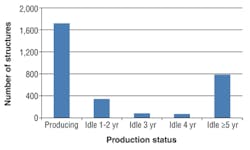Total ups Angola content, maximizes gas for latest 'cluster' project
Jeremy Beckman
Editor, Europe
Construction is under way for CLOV, Total’s fourth deepwater development “pole” in block 17 off Angola. The FPSO is being engineered in South Korea and Singapore, and development drilling should in the second half of next year, with first oil set to flow in 2Q 2014.
The project was sanctioned last August, and the timeframe to start-up of 201 weeks is not the quickest for a development of this scale. But that was mainly due to the drive to maximize the content of Angolan fabrication and integration work, which will be higher than on previous block 17 programs.
As with its predecessors Girassol, Dalia, and Pazflor, CLOV will be produced via a centrally located floater with an extensive SURF spread, but there the similarities end. For one thing, nearly all CLOV’s gas will be harnessed from the outset for the Angola LNG (AnLNG) Project, which comes on stream next year. CLOV will also break new ground for Total in the form of subsea multiphase pumping and all-electric power on the FPSO.
Design changes
CLOV stands for Cravo, Lirio, Orquidea, and Violeta, four fields in the northwest of Block 17 that were discovered and appraised between 1998 and 2006. They are situated 140 km (87 mi) offshore Luanda and 40 km (24.8 mi) northwest of the Dalia field, in water depths ranging from 1,100-1,400 m (3,609-4,593 ft).
Lirio and Cravo contain high-quality Oligocene crude, in Lirio’s case overlain by a large gas cap. At one point, the partners considered a phased development of these fields via the Girassol facilities; but when it emerged that the Miocene crude volumes on Orquidea and Violeta were larger than expected, a new concept gained favor involving a hub on Cravo/Lirio, drawing in reserves from Orquidea and Violeta at a later stage.
In early 2006, after integrating new reservoir data, Total leaned towards a simultaneous development of all four fields, and this was confirmed in February 2007, when CLOV was designated a project. The team is headed by Project Director Genevieve Mouillerat, who was previously FPSO package manager on Dalia.
At CLOV, however, the Oligocene reservoirs account for three-quarters of the total oil reserves of 505 MMbbl. At 0.5-0.6 cp, this oil is some of the best-quality in block 17, with a gravity range of 32-35° API, a low wax content, and no sulfur. Temperature and pressure is also favorable, in the range 75-80° C (167-176° F) and 300 bar (4,351 psi). CLOV’s Miocene oil, which represents a quarter of the reserves, is more viscous and lower quality, with 20-30° API gravity, with lower reservoir temperatures (around 50° C, or 122° F) and pressure (200 bar, or 2,900 psi).
“The combination is not ideal,” Mouillerat said, “but we can separate the commingled crudes in one topsides train. At Dalia, when the effluent arrived at the FPSO, we had to re-heat it to achieve separation. With CLOV, however, the temperature on exiting the reservoirs is high enough to make this unnecessary.”
Process spread
Daewoo Shipbuilding & Marine Engineering (DSME) is EPSCC contractor for CLOV’s FPSO, which is 305 m long, 61 m wide and 32 m deep (1,000 x 200 x 105 ft). The oil production capacity is 160,000 b/d, compared with 250,000 b/d for Girassol/Rosa; 240,000 b/d for Dalia; and 220,000 b/d for Pazflor.
KBR is handling detailed engineering design for the topsides, as a subcontractor to DSME. The vessel’s double-sided, single-bottom hull will support topsides with a dry weight of around 34,000 metric tons (37,478 tons), comprising 11 modules. These will include facilities for oil storage of 1.78 MMbbl; water injection at up to 319,000 b/d; gas compression at up to 6.5 MMcm/d; a compact water treatment unit; and a single train for process and storage of the commingled oils. Following two stages of liquid and gas separation, the oil and water will be separated and desalted in wash tanks with fresh water, followed by stabilization in settling tanks.
The FPSO will be able to accommodate a maximum of 240 personnel. In operation, it will be spread moored in 1,291 m (4,235 ft) water depth, with processed oil exported through two 2-km (1.2-mi), 24-in. (61-cm) offloading lines to a 17-m (56-ft) high, 24-in. diameter oil loading terminal, a rotary-table buoy stationed 1 nautical mile (1.85 km) away. Loading data from the buoy will be conveyed back to the FPSO via a fiber optic cable.
Flow assurance
The four fields are spread, with Lirio and Cravo on one side and Orquidea and Violeta on the other, with distances in between of 9-10 km (5.6-6.2 mi). This introduces thermal and insulation constraints for the interfield flowlines, Mouillerat says. “On the Oligocene reservoirs, our solution is a production loop tying in all the wells – it’s quite a change from the dual-line arrangement on the previous block 17 projects. But the differential pressure for each of the wells will make it challenging for production.”
“To address this, we have made available a ring loop going each way. In the middle of the loop, an in-line tee will allow us to add more wells, depending on production performance or if we find more reserves via future exploration.”
Development drilling will start in 2Q 2012, with two DP drillships – thePride Africa and Seadrill’s newbuild West Gemini – working in parallel, at an average rate of 60 days per well. Total aims to have 15 wells in place for first oil, with drilling likely to continue through 2016.
Cravo/Lirio will be developed with 10 producer wells grouped via four 12-in. (30.5-cm), four-slot seabed manifolds, and linked together via a 17-km (10.6-mi) production loop comprising 12 and 16-in. (30.5/40.6-cm) pipe-in-pipe, with a bottom gas-lift riser. Two 12-in. water injection lines (24 km, or 14.9 mi, in total) will be connected to nine water injector wells, with these and the production lines gathered together in a single rigid riser tower suspended beside the FPSO.
On Orquidea/Violeta, the configuration will be nine producers grouped together on four 10-in. (25.4-cm), four-slot manifolds. Here there will be 21 km (13 mi) of dual production lines of 10 and 14-in. (25.4/36-cm) pipe-in-pipe for transporting commingled Miocene and Oligocene oils, with a bottom lift gas riser. Six water injectors will be connected to two 10-in. water injection lines (33 km, or 20.5 mi, in total), with one rigid riser tower linking the injection/production lines to the CLOV floater
CLOV’s gas will head to the new AnLNG plant in Soyo via a single hybrid riser and a 32-km (19.9-mi) export pipeline with a subsea isolation valve connected to a pipeline end manifold in the AnLNG offshore gas-gathering network. In the event of plant unavailability, there will be back-up solutions to re-inject supplies into other fields in block 17.
Acergy (now Subsea7) was awarded a $1.2-billion contract to engineer, fabricate, and install the SURF spread. FMC is providing 36 subsea trees, wellheads and controls, all eight manifolds, plus associated tie-in/tooling systems, and workover control systems for the two rigs. Mouillerat describes the subsea production facilities – at least for the Oligocene reservoirs – as conventional, in terms of what Total has done before on block 17, “although we do make improvements as we go along and improve our knowledge of the reservoirs,” he noted.
Total opted for riser towers following a design competition. This solution was first devised for Girassol in the late 1990s – the systems there have performed well, she points out. A further consideration was the need to maximize use of Angolan labor – the Sonamet yard has unrivalled experience of assembling and loading out these structures, which are roughly 1,200 m (3,937 ft) high. Compared with the previous structures delivered for Dalia, there will be improvements this time in design/assembly relating to the buoyancy tanks and use of a guide-frame.
Another local organization, Technip’s subsidiary Angoflex, will manufacture CLOV’s 80-km (49.7-mi) network of dynamic and static production and water injection umbilicals at its base in Lobito.
Miocene drive
After 18 months to two years of production, the flow of Miocene fluids from Orquidea/Violeta (50,000 b/d) will be boosted by a 28-metric ton (30.9-ton) multi-phase pumping (MPP) system supplied by Framo, which will be installed around 2-3 km (1.2-1.8 mi) from the FPSO. On Pazflor, Total opted for subsea separation and boosting pumps, but multi-phase pumping in a deepwater setting is a first for the company.
The Orquidea-Violeta MPP system will comprise a pumping station moored to the seabed via a suction anchor. This will contain two helico-axial pumps, one for back-up, operating at 45 bar (652 psi), with shaft power of 1.8 MW transmitted from the FPSO through a 10.6-km (6.5-mi) power and control umbilical. Unlike the equipment on Pazflor, the MPP system will be capable of pumping all effluents, liquids and gas (582 Am3/h), with a gas volume fraction of 53%. The equipment is designed for a 20-year service life in water.
Use of MPP also reduces the need for gas lift on Orquidea/Violeta. With most of CLOV’s associated gas allocated to Angola LNG, there is no scope for gas injection, with only modest amounts of gas set aside for power on the FPSO. “Doing without gas injection saves the cost of one well,” Mouillerat says, “but on the other hand, it’s technologically quite challenging to start production without this – although it is better for the environment. We will never need gas injection on CLOV. We also have a policy of no flaring during normal operating conditions for this project. We have a flare system for safety, but there will be no pilot light, which is again a challenge. Instead, we will have a complex ignition package.”
Power management
The FPSO will be fitted with 100 MW of installed power for operations topsides and subsea. GE was awarded a $114-million contract to supply four LM2500 plus G4 SAC aero-derivative gas turbines for power generation, and five process compressors. The latter, like the water injection and multi-phase pumps, will be electrically driven by variable-speed drive (VSD) systems. This will represent a first for an FPSO anywhere, according to the equipment supplier, Converteam.
The variable-speed drive configuration, supplied by Converteam, which will regulate power on the FPSO.
The Paris-based company is providing medium voltage drives from its MV7000 range, based on the latest press-pack IGBT (PPI) technology and incorporating a PWM 3-level inverter. According to Converteam, the adjustable PWM patterns and frequency allow for wide-ranging flexibility, i.e. low switching losses, low motor THD (total harmonic distortion), high-frequency operation (up to 300Hz), and negligible amplitude of torque pulsation at the motor shaft. The VSDs are water-cooled, optimizing use of high-capacity diodes and PPI, and operating with very low noise levels. They also occupy less space than air-cooled VSDs, with their attendant ventilation/air conditioning equipment.
On CLOV, the arrangement will be:
- Four 9.6 MW HP compressors fed by MV7609, 24-pulse diode front-end and asynchronous motor (6 kV/1,717 rpm)
- One 4.8 MW LP compressor fed by MV7304, 12-pulse diode front end and asynchronous motor (6 kV, 1,717 rpm)
- Two 8.7 MW water injection pumps fed by MV7309, 24-pulse diode front end and asynchronous motor (3 kV/1,900 rpm)
- Two 2.3 MW subsea multiphase pump units fed by MV7304, 12-pulse diode front-end and asynchronous motor (6 kV/3, 800 rpm).
“The all-electric approach,” Mouillerat explained, “is proven to be easier for production personnel to operate – particularly during early field operations, when there will be regular spells of equipment stopping and starting. In addition, these VSDs will enable us to use exactly and only the required amount of power. And they will help us towards the end of production when our power requirements will be lower.”
Also new for Total is the offshore installation of the Minox de-oxygenation system that DSME has ordered from Grenland Group in Norway for the compact water treatment module, due to be delivered early next year. This will be used to treat 280,000 b/d of seawater for injection. VWS Westgarth in East Kilbride, UK, is supplying an associated ultrafiltration system and a sulfate removal package.
According to Mouillerat, CLOV’s topsides layout is determined by safety needs. “There will be no more space available than on the other block 17 floaters – some areas have been ‘left’ to accommodate future tiebacks, but that is the same for any FPSO. What is different is the location of the settling tank for oil treatment in the hull, which leaves us with more room.”
The other main challenge on this project has been to raise local content to new levels of participation. “All pipe double-jointing line pipe is to be performed in Angola, close to the installation site,” she points out.” When the FPSO arrives from South Korea in 2013, it will be moored in a quayside for installation of the water treatment module on the topsides, which will also be fabricated in Angola.
Altogether, Total estimates that CLOV will provide 9 million man-hours of work for Angolans, representing 20% of global cost of the project for local fabrication and assembly. Angolan labor will account for 64,000 metric tons (70,548 tons) of fabrication and assembly – including 7,704 m tons (8,492 tons) for the FPSO – and nearly 60% of the SURF package.
Total E&P Angola operates block 17 with a 40% interest, in partnership with Statoil (23.33%), Esso Exploration Angola (20%), and BP Exploration Angola (16.67%). Sonangol is the concessionaire.
Offshore Articles Archives
View Oil and Gas Articles on PennEnergy.com



